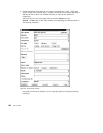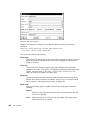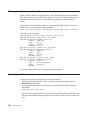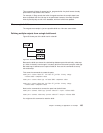
In our example, each of the build servers receives a compile event to perform. Each
extracts the .c source files it needs from the TeamConnection database and the
contents of the build script for the c_compiler builder. The build servers then run their
build scripts.
The results (the .obj files and the return code) are sent back to the build servers. After
updating the TeamConnection database, the build servers re-enter the polling loop to
see if any more build events await their attention.
Because the compile steps are performed in parallel, Greg can build this application a
little more quickly than if they had happened in serial mode. In this simple example, the
difference is hardly noticeable; but in a large build of hundreds of parts, with multiple
build servers available on a local area network, the performance improvement can be
enormous.
Finishing the job and reporting the results to the user
The processing described by the previous two steps is repeated until there are no more
build events remaining. The results of the build are displayed in the Build Progress
window or in stdout. At this point the build is complete.
To complete our example, the previous two steps are repeated to complete the link
step, using either of the build servers in pool1. Greg now can extract the resulting
executable from TeamConnection, using the part -extract msgcat.exe command, and
run it.
Monitoring the progress of a build
During the course of a build, you can monitor its progress in several ways:
v If the build was started from the command line, by issuing the report -view partview
command against the work area in which you are building. From this report, you can
determine the states of the parts. Use the part -viewmsg command to see the build
messages issued because of a failed build. For complete syntax of these commands,
refer to the
Commands Reference
v If the build was started from the GUI, in the Build Progress window. You can find the
same information by looking at stdout.
Greg can see how the build is progressing by checking the Build Progress window. For
example, he might see these messages:
6021-700 Number of distinct build events for this build: 3.
Build of 'hello.obj' started at '15:33:47 1995-08-10'
via a build agent on the host 'OCTOFVT'.
Build of 'hello.obj' successfully completed at '15:34:45 1995-08-10'.
Completed Jobs: 1
Remaining Jobs: 2
Build of 'bye.obj' started at '15:34:49 1995-08-10'
via a build agent on the host 'OCTOFVT'.
192 User’s Guide


















